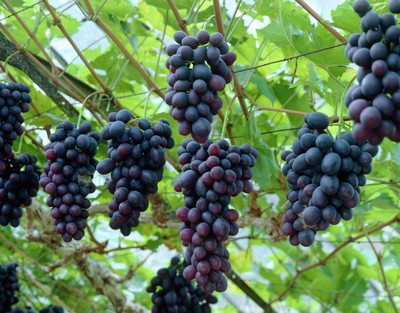
Common Name: Angoor, Draksha, Munacca
English Name: Grapes
Botanical Name: Vitis vinifera Linn.
Family: Vitaceae
Description: Perennial, woody climbing vine; stems up to 35 m long, but in cultivation usually reduced by annual pruning to 1–3 m; leaves thin, circular to circular-ovate, 5–23 cm broad, margins dentate or jagged, basal sinus deep and lobes often overlapping, 5–7-lobed, glabrescent above, often with persisten tomentum beneath; tendrils branched, normally opposite 2 leaves out of three; flowers numerous, in dense panicles or thyrses opposite leaves.
Chemical Constituents: Grapes contain fruit acids, and the unripe fruit contains 34 ppm oxalic acid.2,4 Grape seeds contain 6-20% oil. Phenols are the third most-abundant constituent in grapes; trans-resveratrol, catechin, epicatechin, quercetin.Melatonin, pectin, tannins, proteins, anthocyanins, waxes, flavonoids, xanthophylls, carotene, vitamins and procyanidins Potassium and calcium bitartrate, calcium malate, fruit acids, sugar, flavonoids, and tannins are part of the composition.
Properties: Lipoprotein oxidation of low density (LDL) by free radicals is associated with initiation of atherosclerosis. The active ingredients of the grape reduce formation of this lipoprotein.Leaves have venotonic, vasoprotective, astringent and diuretic effects.The fruits are vitaminics, tonics, anticancer, hepatoprotective, promote hair growth and prevent ischemic processes.The seeds oil: Hypolipidemic, prevents the increase of vascular permeability.
Used in the following MATXIN products: